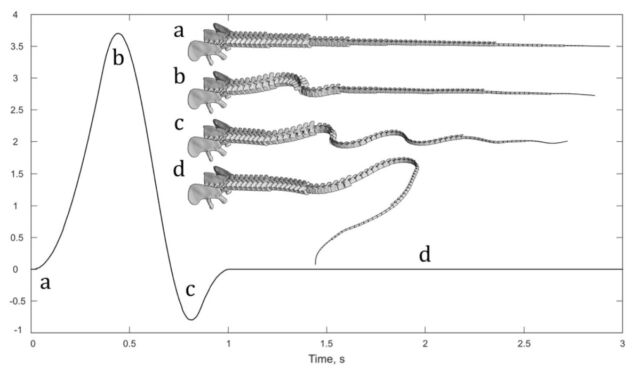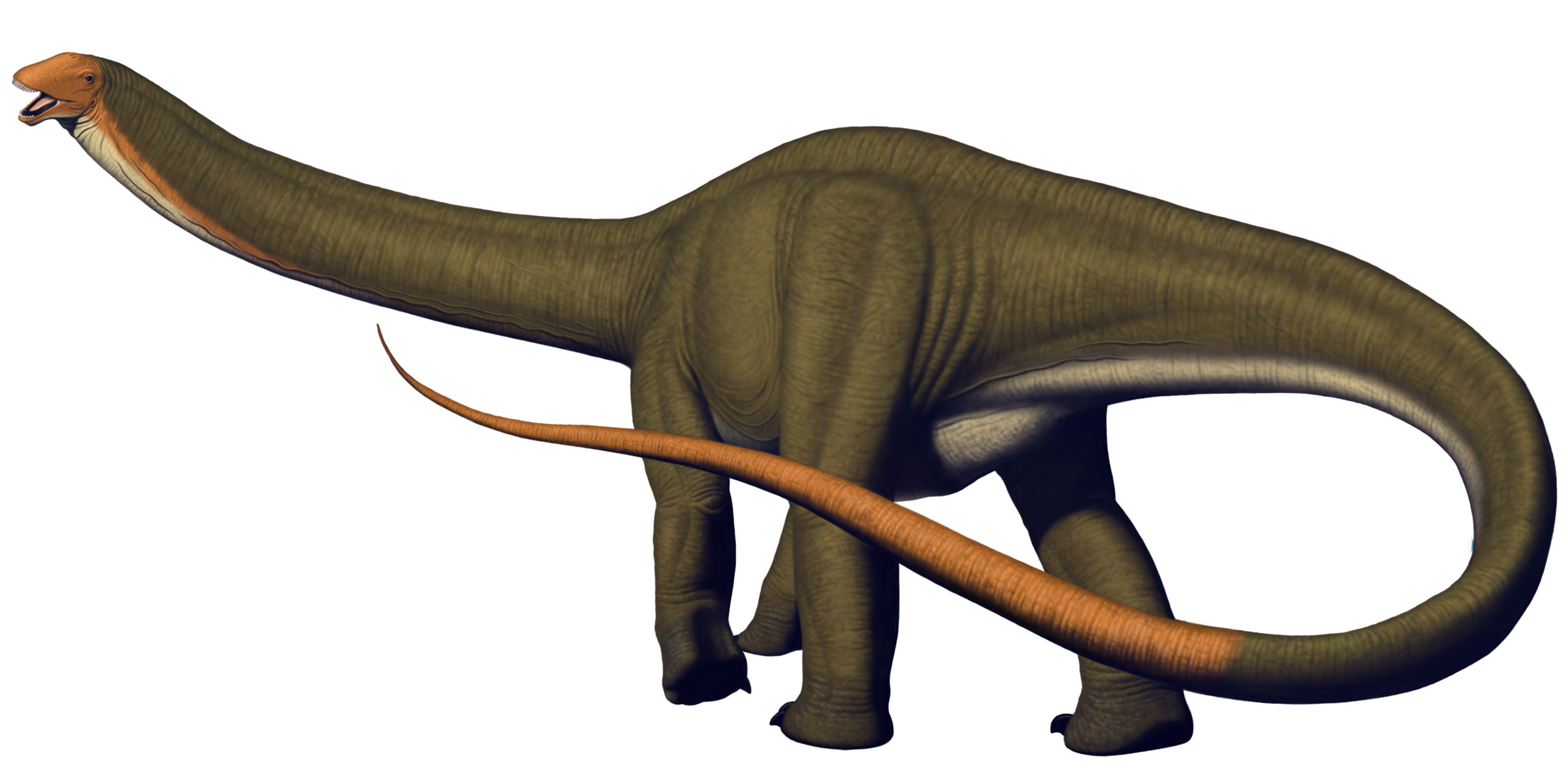Back in 1997, Microsoft's then-CTO, Nathan P. Myhrvold, made headlines when his computer simulations suggested that the enormous tails of sauropods—specifically Apatosaurus—could crack like a bullwhip and break the sound barrier, producing a sonic boom. Paleontologists deemed it an intriguing possibility, although several were skeptical. Now a fresh team of scientists has tackled the issue and built its own simulated model of an Apatosaurus tail. They found no evidence of a sonic boom, according to a new paper published in the journal Scientific Reports. In fact, the maximum speed possible in the new simulations was 10 times slower than the speed of sound in standard air.
While still at Microsoft in the 1990s, Myhrvold—a longtime dinosaur enthusiast—stumbled upon a book by zoologist Robert McNeill Alexander speculating about whether the tails of certain sauropods may have been used like a bullwhip to produce a loud noise as a defensive strategy, a mating call, or other purpose. The structure somewhat resembles a bullwhip, in that each successive vertebra in the tail is roughly 6 percent smaller than its predecessor. It was already well-known in physics circles that the crack of a whip is due to a shock wave, or sonic boom, arising from the speed of the thin tip breaking through the sound barrier.
Myhrvold wanted to put that speculative suggestion to the test, and struck up an email correspondence with paleontologist Philip J. Currie, now at the University of Alberta in Edmonton, Canada. (Fun fact: Currie was one of the inspirations for the Alan Grant character in Jurassic Park.) The two men analyzed fossils, developed computer models, and conducted several computer simulations to test the biomechanics of the sauropod's tail. They also compared those simulations to the mechanics of whips.
They concluded that a side-to-side flick of the tail could send a wave of energy accelerating along the length of the appendage, gaining momentum so that the tip of the tail reached speeds of more than 750 miles per hour. The speed of sound changes depending on the medium and ambient conditions, like temperature, but it's generally pegged at 740 MPH in air at 0° C (32° F). Myhrvold and Currie noted in their published paper that only the last two to three inches of the tail would reach those supersonic speeds. They also suggested that the furthest part of the tail could have extended past the last vertebra by virtue of a piece of skin, tendon, or keratin—similar to the tips of whips made of cow or kangaroo skin, which are robust enough to withstand supersonic speeds.
Myhrvold gave an update on his research at a conference in 2002, reporting a maximum potential speed of 1,300 mph, which would have produced a sonic boom of around 200 decibels. Among other evidence: Some fossil specimens of sauropods have fused vertebrae in a key transition zone between the stiff base and the flexible section of the tail—much like a bullwhip eventually fails near the junction between the thick handle and the flexible leather portion.
Paleontologist Kenneth Carpenter was one of the most outspoken skeptics of the sonic boom hypothesis. "To be blunt, the computer simulations are another case of garbage in, garbage out," he told The New York Times in 1995. Carpenter said he would be more receptive to the idea if a scale model could be built. It took nearly 20 years, but Myhrvold presented just such a model at the 2015 Society of Vertebrate Paleontology conference.

Made of aluminum, stainless steel, neoprene, and Teflon, the model was 12 feet long (3.6 meters), or roughly one-quarter the size of an actual sauropod tail. All 82 bones in the tail were included with the correct joint angles, and Myhrvold placed weights on each vertebra to simulate the weight of flesh. There was also a "popper" at the end: a bit of treated leather to simulate the tip of a bullwhip. The model was attached to a camera tripod, representing the "dinosaur butt." Myhrvold et al. then performed a series of tests, tugging on the tripod handle to cause the model tail to swing around, producing sharp "cracks" like a bullwhip. They caught all the tests on high-speed video to ensure exact measurements.
The model tail reached speeds of 360 meters per second, or about 805 mph. Carpenter was impressed but still had his doubts, noting that the scale model lacked the connective structures from one vertebra to the next in the tail, which would have restricted the side-to-side motion, as would layers of skin and muscle. As for the popper, Carpenter told Live Science that cracking its tail at supersonic speeds would likely cause the skin at the tip to break or bleed, eventually leading to inflexible scar tissue. "I have a hard time envisioning evolution taking sauropod tails down a path of having a structure that could only be used a few times and then is worthless," he said.
That brings us to this latest paper. Along with several colleagues, Simone Conti of the NOVA School of Science and Technology in Portugal set out to improve upon earlier computer simulations by employing more of a multi-faceted approach. They combined state-of-the-art multi-body modeling with simulations of soft tissue resistance to stress to test the biomechanical performance of the Apatosaurus tail.

Their model tail was more than 30 feet (12 meters) long and weighed 3,187 pounds (1,446 kilograms). It had 82 cylinders representing the vertebrae attached to a fixed hip bone base, which moved in an arc to cause the tail to move with a whip-like motion. The maximum speed of their model tail was just 33 meters per second, or just under 74 mph—much too slow to generate a sonic boom—suggesting that sauropod tails were much stiffer than previously thought.
Furthermore, when they did subject the model tail to supersonic speeds, the tail inevitably broke, unable to withstand the stress. Conti et al. also tried adding structures to mimic the tip of the bullwhip to their simulations: one with three segments of skin and keratin; one made of braided keratin filaments; and one made of soft tissues. None of those could withstand the stresses of supersonic speed, either.
"The hypothesis of a sauropod supersonic tail is unsupported by the evidence obtained by the computer simulation and the estimates on the stress-bearing of soft tissues," the authors concluded in their paper. "The limitation at the base of the tail imposed with the articulation with the sacrum and the action of air drag reduces the maximum speed achievable. A soft tissue popper would not withstand the high stresses imposed by the motion at the speed of sound since the increased mass would lead to failure of the tail, or the increased air drag would further reduce the tail speed."
DOI: Scientific Reports, 2022. 10.1038/s41598-022-21633-2 (About DOIs).
Listing image by Simone Conti



3175x175(CURRENT).thumb.jpg.b05acc060982b36f5891ba728e6d953c.jpg)
Recommended Comments
There are no comments to display.
Join the conversation
You can post now and register later. If you have an account, sign in now to post with your account.
Note: Your post will require moderator approval before it will be visible.